The Intel Core i3-7350K (60W) Review: Almost a Core i7-2600K
by Ian Cutress on February 3, 2017 8:00 AM ESTProfessional Performance: Windows
Agisoft Photoscan – 2D to 3D Image Manipulation: link
Agisoft Photoscan creates 3D models from 2D images, a process which is very computationally expensive. The algorithm is split into four distinct phases, and different phases of the model reconstruction require either fast memory, fast IPC, more cores, or even OpenCL compute devices to hand. Agisoft supplied us with a special version of the software to script the process, where we take 50 images of a stately home and convert it into a medium quality model. This benchmark typically takes around 15-20 minutes on a high-end PC on the CPU alone, with GPUs reducing the time.
Here we report the overall time to complete the test – sub-test results can be found in Bench.
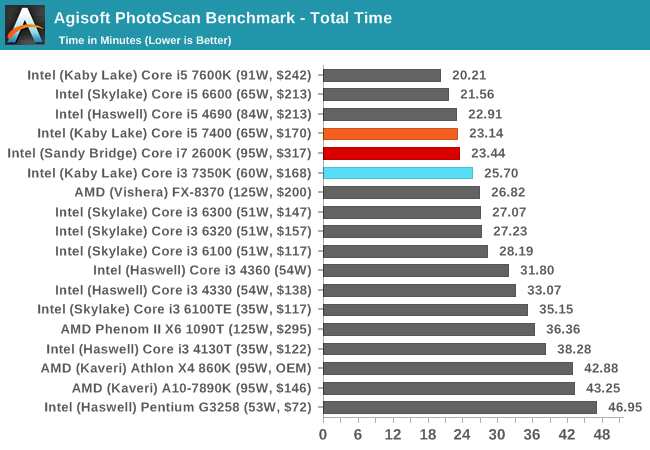
Photoscan is a mix of single and multi-threaded segments, but overall the extra cores in the i5/i7 beat the Core i3, but not by much.
Cinebench R15
Cinebench is a benchmark based around Cinema 4D, and is fairly well known among enthusiasts for stressing the CPU for a provided workload. Results are given as a score, where higher is better.
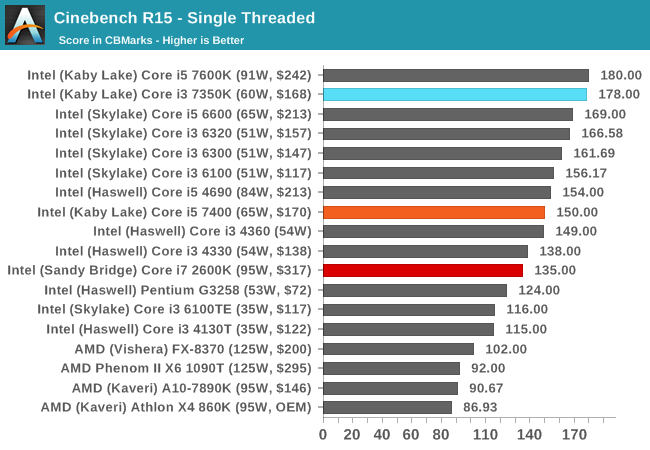
All the Kaby Lake processors seem to do well in CB15 single threaded performance, given that all the K-processors can reach 4.2 GHz or higher one way or another. Nonetheless, the age of the Core i7-2600K is showing here.
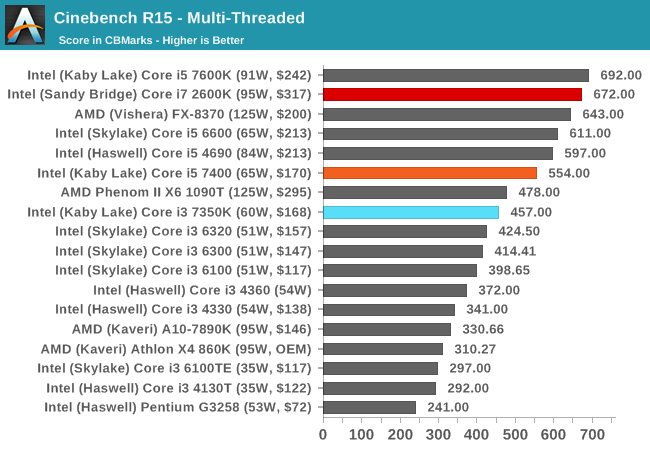
Turning the tables with actual cores, and the Core i7-2600K gets a significant leg up here. The Core i5 also sits above the Core i3.
HandBrake v0.9.9: link
For HandBrake, we take two videos (a 2h20 640x266 DVD rip and a 10min double UHD 3840x4320 animation short) and convert them to x264 format in an MP4 container. Results are given in terms of the frames per second processed, and HandBrake uses as many threads as possible.
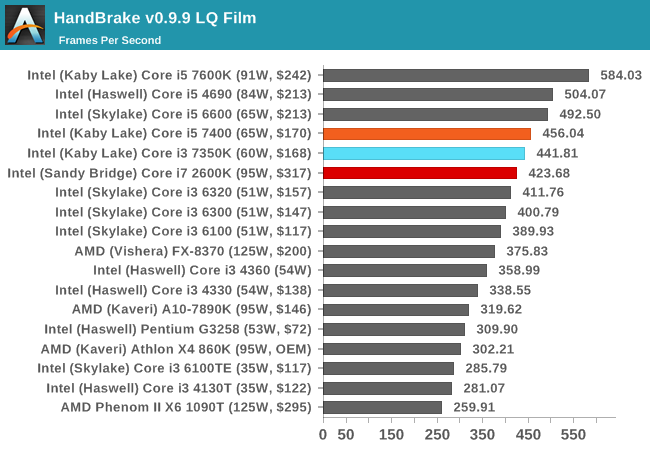

For video conversion, having small frames puts all three CPUs in a similar spot. But ramp up the frame size and we see the Kaby Lake i5 pull ahead due to IPC and instructions. The Core i3 has enough oomph to match the extra threads on the Core i7-2600K though.
Hybrid x265
Hybrid is a new benchmark, where we take a 4K 1500 frame video and convert it into an x265 format without audio. Results are given in frames per second.
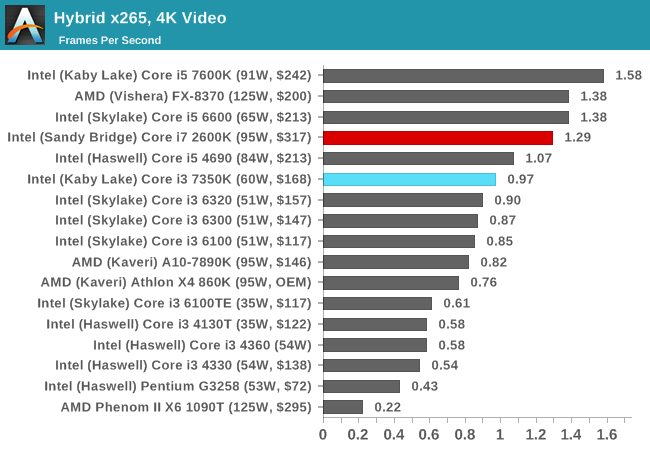
With a different video conversion tool and render, the extra cores and threads of the Core i7 is more than enough to give it a 30% advantage over the Core i3-7350K. It makes me wonder if another +30% frequency would help the Core i3.










186 Comments
View All Comments
silverblue - Saturday, February 4, 2017 - link
It's a bit weird, but most of them are within margin of error.WoodyBL - Saturday, February 4, 2017 - link
Am I the only one noticing that the i5-4690 was beating the i5-7600k in a lot of benchmarks? I'm having a hard time processing how that was even possible...fanofanand - Sunday, February 5, 2017 - link
Wasn't the 4690 Devil's Canyon? Similar IPC higher clocks I would assume. Most of the changes lately have been hardware decoders/encoders and I/o changes. Intel takes baby steps because it can, hopefully that changes with Ryzen.WoodyBL - Saturday, February 4, 2017 - link
Am I the only one noticing that the i5-4690 was beating the i5-7600k in a lot of benchmarks? I'm having a hard time processing how that was even possible...yankeeDDL - Saturday, February 4, 2017 - link
Glad to see that my 2 years old A10 still trashes anything Intel on integrated graphics.Gothmoth - Saturday, February 4, 2017 - link
no wonder intel is not selling to consumers, complaining about stagnation.the money they make comes from enterprise i guess.
i have not updated my sandy bridge for 6 years.
and i will not until intel gives me a reason.. this is only babysteps.
i had to cash out 1200 euro for a new mobo, cpu, ram, cooler... and for what.... 30% more performance..... meh
TelstarTOS - Saturday, February 4, 2017 - link
"Responsiveness? Top class."No way. It will suck in heavy multitasking.
synth0 - Sunday, February 5, 2017 - link
This is how good a 2011 chip really is!This shows there really isn't much sense to upgrade a PC anymore, and with time it will get even less sense to invest money for an upgrade. What will be in 2024? Are we entering into a stalemate in the PC area?
lopri - Sunday, February 5, 2017 - link
An excellent review but I would rather get a 7600K. Oh, wait. I already have something similar: 2600K.Bullwinkle J Moose - Sunday, February 5, 2017 - link
"The Intel Core i3-7350K (60W) Review: Almost a Core i7-2600K"---------------------------------------------------------------------------------------
.....and not even CLOSE to a Sandy Bridge!
Can the Intel Core i3-7350K use my Optical port in DRM crippled Windows 10 for Audio Production?
Show me how!
Can I record what I hear on the desktop with the DRM crippling API's found in Windows Vista / 7 / 8 and 10 ?
Show me how!
Will it boot "directly" to Windows XP faster than I can on my 35 watt dualcore Sandy Bridge (3-seconds on a Samsung 850 Pro SSD) so I CAN use my optical ports and record whatever I want without a DRM crippled Spyware Platform, or do the new motherboards prevent me from booting to a NON-crippled O.S. like my copy of Windows XP?
Well?
Should I "upgrade" to a crippled platform that prevents me from doing ANYTHING I want to do, but allows me to do only what Microsoft graciously allows me to do?
........ and explain to me again why I should pay more for my own enslavement?